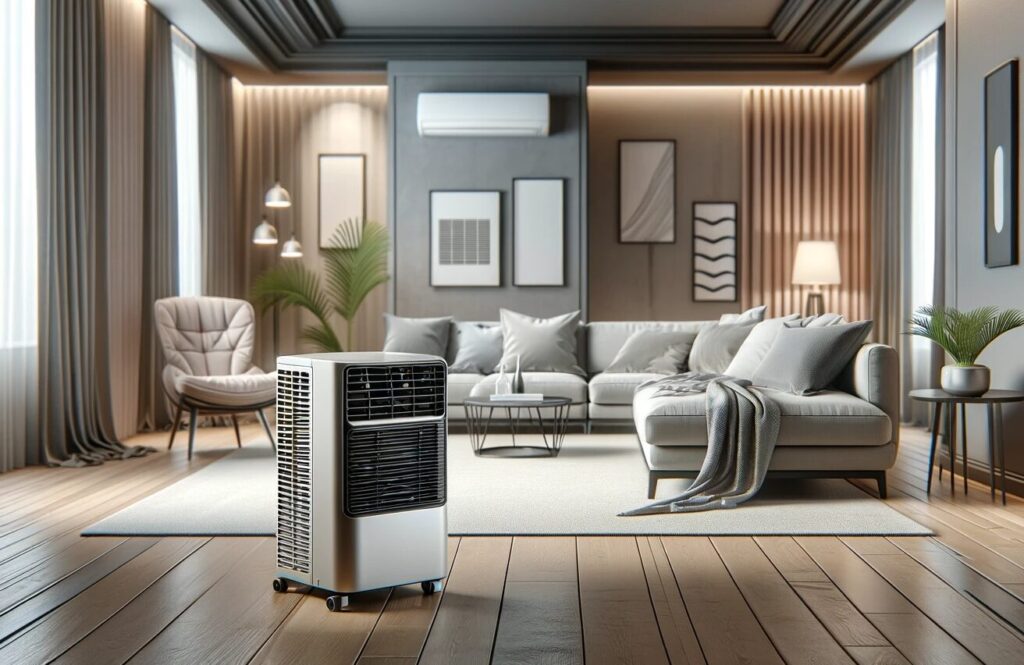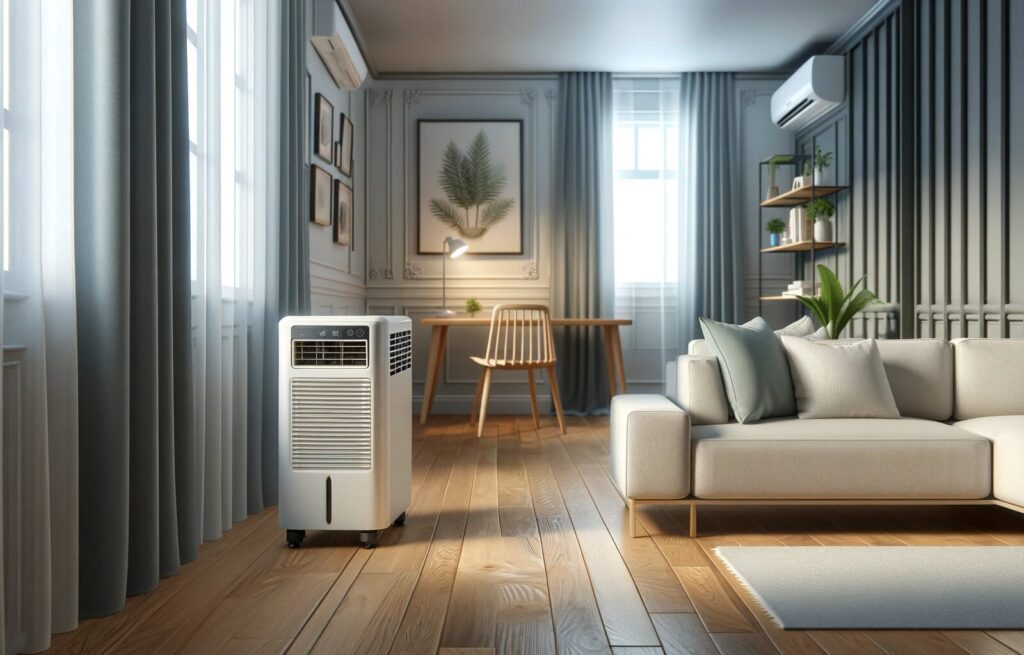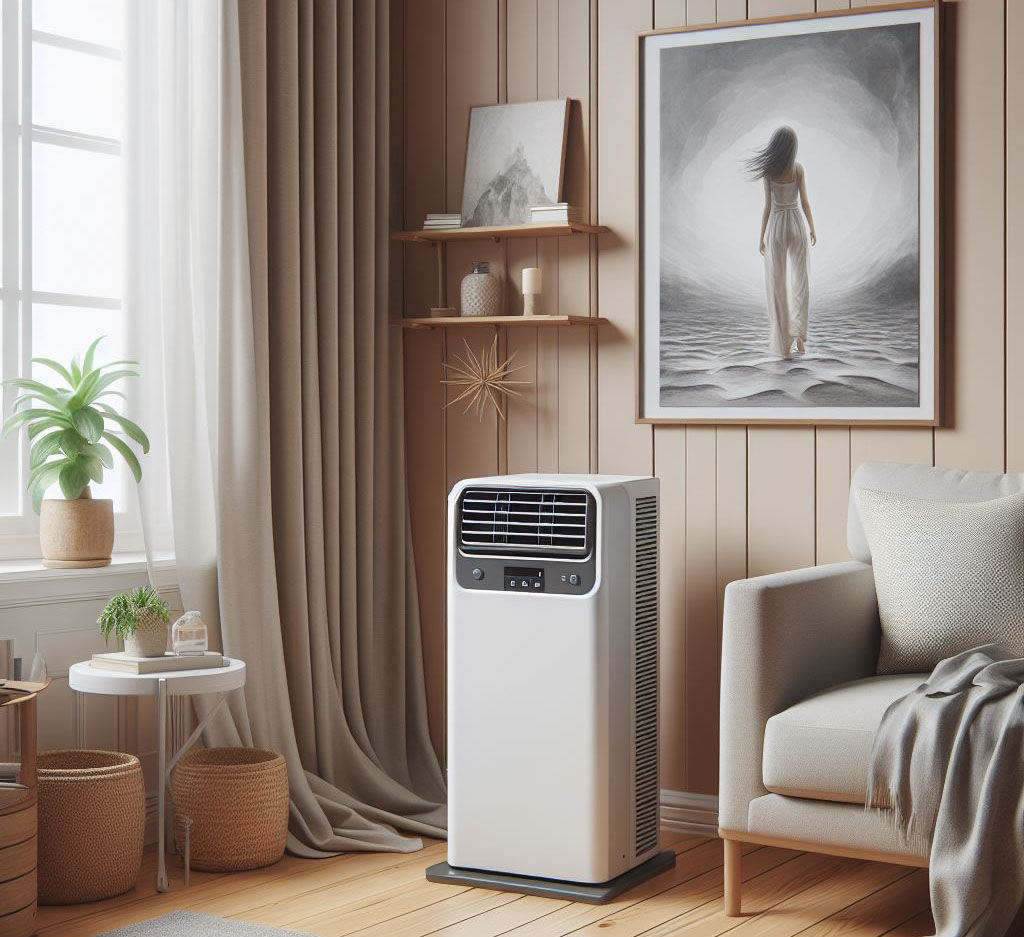In the thick of summer, when the mercury climbs and the humidity hangs heavy like a wet blanket, portable air conditioners have risen as the unsung heroes on many job sites. These compact units are more than just a convenience, they’re a necessity for comfort and productivity when the heat is on.
For the savvy home handyman or the seasoned construction professional, a keen grasp of the inner workings of portable AC units is as essential as a well-organized toolbox. Knowing whether these units are up to snuff can make or break the livability of a space during those dog days of summer.

Understanding Portable Air Conditioners
What we’re talking about here are portable air conditioners—freestanding units that can be moved from room to room, providing a cool breeze where it’s needed most. They’re a far cry from the behemoth window units of yesteryear, offering a modern solution for cooling spaces that are either too remote or too temporary for traditional setups.
These units shine in a variety of settings:
- On the Fly: When you’re bouncing between job sites and need a quick cooling solution.
- Rental Properties: Where the rules say ‘no’ to permanent fixtures or window units.
- Hot Spots: Those stubborn areas in a home that central air can’t seem to touch.
How Do Portable Air Conditioners Work?
Beneath the shell of these portable coolers lies a symphony of components working in concert to bring down the temperature. Let’s walk through the ensemble:
- Compressor: This is the driving force, circulating the refrigerant that carries the heat out of your air.
- Condenser Coil: Think of this as the heat exchanger, it’s where the indoor heat is transferred to the outdoors.
- Evaporator Coil: Here’s where the refrigerant gets cold, allowing the coil to absorb heat from the air and cool it down.
- Fan: This component does the heavy lifting of circulating air over the evaporator coil and back into the room.
- Exhaust Hose: Acting as the escape route, this hose directs the hot air out of the room.

Now, let’s break down the cooling process into steps you can follow:
- Hot Air Influx: The unit draws in the warm air from your space, passing it over the chilled evaporator coil.
- Heat Transfer: As the warm air crosses the coil, the refrigerant captures the heat, leaving the air cooler as it passes by.
- Chilled Air Dispatch: The fan then propels this cooled air back into the room, dropping the temperature bit by bit.
- Heat Expulsion: The now-warm refrigerant cycles to the condenser coil, where it releases the absorbed heat to the outside world via the exhaust hose.
- Refrigerant Reset: The refrigerant, having offloaded the heat, travels back to the evaporator to start the cycle anew.
The Pros and Cons of Portable Air Conditioners
In the realm of climate control for the ever-changing environments of construction and renovation, portable air conditioners have carved out their niche quite effectively. They offer a versatile solution to the often temporary but urgent need for cooling. However, as with any tool in the builder’s kit, they come with their own set of strengths and limitations.
Advantages
- Mobility: The ease with which these units can be transported from one room to another is unparalleled. Their design caters to the dynamic nature of renovation work, where the cooling needs may shift as the project progresses.
- Ease of Installation: Unlike more permanent fixtures, portable air conditioners require minimal setup. This plug-and-play approach saves valuable time and effort, which is particularly beneficial in a trade where time is often equated with cost.
- Spot Cooling: For cooling specific areas or providing additional relief in spaces where existing cooling systems fall short, these units are quite effective. They can be strategically placed to ensure comfort where it’s most needed, such as in rooms filled with freshly applied joint compound that requires a controlled climate to properly set.

Drawbacks
- Cooling Capacity: It’s important to have realistic expectations regarding the capabilities of portable air conditioners. They are designed for smaller spaces and can struggle to maintain comfortable temperatures in larger areas or during extreme heat.
- Noise Levels: The operational noise can be a distraction, particularly in residential settings or environments where communication is key. The hum or drone of the unit may be a trade-off for the cooling it provides.
- Space Considerations: These units can be somewhat bulky and may compete for space in areas where square footage is at a premium. Additionally, the necessity to vent the hot air outside through a window or other opening requires planning and can impact the aesthetics of a room.
Efficiency Matters: Do Portable Air Conditioners Use a Lot of Electricity?
When considering the use of portable air conditioners, energy consumption is a topic that warrants attention. These units can be less energy-efficient than their window-mounted or central system counterparts, but with judicious use, they can still be a cost-effective cooling solution.
Tips for Keeping Your Costs Down:
- Size Appropriately: Select a unit with a BTU rating that matches the size of the space you intend to cool. An oversized unit will cycle off and on more frequently, using more energy in the process.
- Seal the Space: Ensure that the area is well-insulated and free from drafts. Every cubic foot of hot air that enters the space is a cubic foot of air that must be cooled anew.
- Proper Venting: Effective venting is crucial. Make sure the exhaust hose is directed out of the space so that the hot air does not negate the cooling effect of the unit.
- Regular Maintenance: Clean the air filters regularly to maintain airflow and efficiency. A clean filter allows the unit to perform at its peak with less strain on the system.
- Smart Operation: Use the unit strategically. Operate it during the hottest parts of the day or when the space is occupied. When possible, take advantage of cooler outdoor temperatures to naturally reduce indoor heat.
Are Portable Air Conditioners Good for Your Specific Needs?
When it comes to cooling a specific area of your home or job site, portable air conditioners can be a highly effective solution. Their convenience and ease of use make them a popular choice for a variety of scenarios, but they are not a one-size-fits-all solution. Let’s explore the situations where they shine and where alternative options may be more appropriate.
Scenarios where portable air conditioners are an excellent choice
- Temporary Residences: If you’re in a lease where modifications are a no-go, a portable AC can provide the comfort of cool air without the permanence of installation.
- Targeted Cooling Needs: When certain rooms in your home become unbearably hot, these units can deliver relief directly where it’s needed, without the need to overhaul your central air.
- Homes with Atypical Windows: For those with windows that don’t conform to standard dimensions or types, portable air conditioners offer a flexible alternative that doesn’t require the window space that traditional units do.
- Short-Term Work Environments: On the job site, whether it’s a temporary office or a newly constructed space awaiting permanent HVAC, portable air conditioners can offer a reprieve from the heat for workers.
Situations where alternative cooling solutions might be better
- Large-Scale Cooling: If you’re looking to drop the temperature in a whole house or large open space, central air conditioning or multiple window units will likely serve you better.
- Quiet Environments: In spaces where noise is a concern, such as recording studios or bedrooms, the operational noise of a portable unit may be disruptive.
Installation and Maintenance
Basic guide on how to install a portable air conditioner
- Choose the Right Spot: Ideally, place the unit close to a window and an electrical outlet. Ensure the area around the unit is free from furniture or curtains to allow for proper airflow.
- Install the Window Kit: Use the kit provided to create a seal in the window where the exhaust hose will be fitted. It’s essential to ensure a tight fit to prevent warm air from re-entering the room.
- Connect the Exhaust Hose: Attach one end of the hose to the unit and the other to the window kit. Aim for a straight path to ensure efficient exhaust.
- Power Up: Once everything is in place, plug in the unit. Many models will have a variety of settings, so familiarize yourself with the controls for optimal operation.
Maintenance tips to ensure longevity and optimal performance
- Filter Maintenance: Regularly clean or replace the air filters to prevent dust and debris from hindering performance.
- Seasonal Storage: When not in use, drain any excess water from the unit, clean it, and store it in a dry place to prevent mold and mildew growth.
- Water Drainage: For models that collect condensation, be diligent about emptying the water reservoir to maintain efficiency and prevent overflow.
FAQ Section
Cooling Efficiency: Window units are generally more efficient because they expel warm air directly outside, whereas portable units can lose some cooling power through the exhaust hose.
Guidelines for Sizing: A unit’s cooling capacity is measured in BTUs. As a rule of thumb, you’ll need roughly 20 BTUs for each square foot of space you want to cool.
Dehumidifying Function: Most portable air conditioners also act as dehumidifiers to some extent. However, if you live in an exceptionally damp climate, a dedicated dehumidifier might be necessary for optimal comfort.
Venting Requirements: Proper venting is crucial. The exhaust hose should lead outside through a window or other dedicated vent to prevent warm air from circulating back into the room.
Water Collection Maintenance: This can vary widely depending on the model and the humidity level of your environment. Some units evaporate much of the moisture they collect, while others will need to be emptied more frequently.
